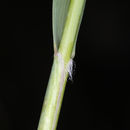Physical Description
provided by USDA PLANTS text
Perennials, Terrestrial, not aquatic, Stems nodes swollen or brittle, Stems erect or ascending, Stems caespitose, tufted, or clustered, Stems terete, round in cross section, or polygonal, Stem internodes hollow, Stems with inflorescence less than 1 m tall, Stems wi th inflorescence 1-2 m tall, Stems, culms, or scapes exceeding basal leaves, Leaves mostly basal, below middle of stem, Leaves conspicuously 2-ranked, distichous, Leaves sheathing at base, Leaf sheath mostly open, or loose, Leaf sheath smooth, glabrous, Leaf sheath and blade differentiated, Leaf blades linear, Leaf blades 2-10 mm wide, Leaf blade margins folded, involute, or conduplicate, Leaf blades mostly glabrous, Leaf blades scabrous, roughened, or wrinkled, Ligule present, Ligule an unfringed eciliate membrane, Inflorescence terminal, Inflorescence a contracted panicle, narrowly paniculate, branches appressed or ascending, Inflorescence solitary, with 1 spike, fascicle, glomerule, head, or cluster per stem or culm, Flowers bisexual, Spikelets pedicellate, Spikelets dorsally compressed or terete, Spikelet less than 3 mm wide, Spikelets with 1 fertile floret, Spikelets solitary at rachis nodes, Spikelets all alike and fertille, Spikelets bisexual, Spikelets disarticulati ng above the glumes, glumes persistent, Spikelets disarticulating beneath or between the florets, Rachilla or pedicel glabrous, Glumes present, empty bracts, Glumes 2 clearly present, Glumes equal or subequal, Glumes equal to or longer than adjacent lemma, Glumes 3 nerved, Lemma coriaceous, firmer or thicker in texture than the glumes, Lemma 5-7 nerved, Lemma body or surface hairy, Lemma apex dentate, 2-fid, Lemma distinctly awned, more than 2-3 mm, Lemma with 1 awn, Lemma awn 1-2 cm long, Lemma awn 2-4 cm long or longer, Lemma awn from sinus of bifid apex, Lemma awn twisted, spirally coiled at base, like a corkscrew, Lemma awn twice geniculate, bent twice, Lemma margins inrolled, tightly covering palea and caryopsis, Lemma straight, Callus or base of lemma evidently hairy, Callus hairs shorter than lemma, Lemma surface pilose, setose or bristly, Palea present, well developed, Palea membranous, hyaline, Palea shorter than lemma, Stamens 3, Styles 2-fid, deeply 2-branched, St igmas 2, Fruit - caryopsis, Caryopsis ellipsoid, longitudinally grooved, hilum long-linear.
Eriocoma pinetorum: Brief Summary
provided by wikipedia EN
Eriocoma pinetorum is a species of grass known by the common names pinewoods needlegrass and pine needlegrass. It is native to most of the western United States from California to Montana to New Mexico, where it grows in woodland and forest in rocky mountainous areas.
- license
- cc-by-sa-3.0
- copyright
- Wikipedia authors and editors

